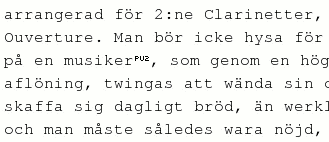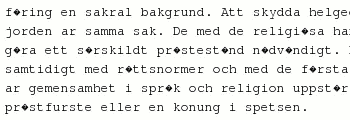Update: In December 2012, all of Project Runeberg's scanned
works were converted from ISO 8859-1 (Latin-1) to UTF-8 (Unicode), as
described in "Projekt Runebergs
konvertering till Unicode" (in Swedish).
Unicode Character Set
by Lars Aronsson, March 2006.
Are you seeing strange, broken or missing letters on
Project Runeberg's website?
Here is an explanation why that can happen, and how we can help each
other by reporting errors and fixing problems. If you have any
questions, write to the
editors@runeberg.org
Historic Background
Computers are numeric machines. Internally, they can only handle
numbers. When we use them for text, every letter and other printable
symbol is represented by a number. This representation must follow
some rule, known as a character set.
In the oldest time, all computer storage was expensive and very
limited character sets were used. Already in the 1960s, the American
Standard Code for Information Interchange, or ASCII, was
designed to allow for 128 different characters, including the 26
letters of the English alphabet in both UPPER and lower case, the 10
digits, comma, period, colon, parentheses, brackets, apostrophe, and a
handful of other useful symbols. What ASCII didn't contain was
accented characters (àéñ) and Scandinavian
letters (åäöæøðþ).
When Project Runeberg was new in 1992, ASCII was slowly being
replaced by extended character sets of twice the size, or 256
characters. We settled for one called ISO 8859-1. As can be
seen from the name, this is an international standard from the United
Nations' International Organization for Standardization (ISO). The
standard ISO 8859 defines a whole family of character sets, where the
version 8859-1 contains the characters used in Northern and Western
Europe, including Scandinavia. It is also known as Latin-1. This was
a natural choice because it was the default character set in the Linux
operating system and the X Window System. Microsoft also adopted it
as its default, starting with Microsoft Windows version 3.1.
The World Wide Web was also new in the early 1990s and since ASCII
wasn't quite dead yet, the HTML file format can use ASCII to write any
non-ASCII character, in a way known as an HTML entity. Such
entities start with the ampersand (&), followed by the character's
name written in ASCII and a semicolon (;). For example, the letter
ä is known as ä which is short for a-with-umlaut. In
addition to this, numeric HTML entities use the hash sign (#)
followed by a decimal number instead of the character's name. Since
the letter ä happens to be number 228, it can be written as
ä as well.
The numbers used in numeric HTML entities must go way beyond 256 to
represent all Greek, Arabic, Hebrew, Russian, Chinese, and Japanese
characters. The full list of several hundred thousand letters is
called the Universal Character Set (UCS), also known as
Unicode. This too is an international standard, ISO 10646,
first published in 1990. Version 3 was published in the year 2000.
While HTML entities have the double advantage of representing all
strange letters in plain old ASCII, and being a de facto
standard on the web, they also have drawbacks. When possible, it is
always preferable to use a "native" encoding rather than ASCII.
Project Runeberg has used ISO 8859-1 from the start in 1992, and
always avoided HTML entities. As the years have gone by, we have felt
an increasing need for changing to a full Unicode representation. At
the same time, the increasing support for Unicode in commonly used
operating systems and web browsers have made it possible for us to do
this transition. However, this is not an easy decision. We believe
that Microsoft Windows 95, almost as old as Project Runeberg, is still
being used, and doesn't fully support Unicode. We don't want to leave
our users behind.
Project Runeberg's Transition to Unicode
In February 2005, Pieni
Tietosanakirja, a small encyclopedia in Finnish, was the first
work we published in Unicode. This is because it contains the letters
š and ž sometimes used in older Finnish texts, that are
not available in Latin-1. For our Unicode files, we have settled for
an encoding known as UTF-8, short for the 8-bit Unicode
Transformation Format.
All new works that we have digitized after the summer of 2005 have
been published in UTF-8.
Our plan is also to convert all previously published works to
UTF-8, but we're moving slowly, one work at a time. Some works that
need Greek letters for mathematical equations have been converted
early. When we digitize a new volume of a journal, we try to convert
all previously digitized volumes, so the entire work will use the same
character set. With time, more and more works will be converted.
Problems
The conversion can cause problems, resulting in letters that are
missing or broken. This can be caused by software problems on our
side, or by lacking Unicode support in your web browser or operating
system. Either way, Project Runeberg's editors are interested to
learn what the problems can be and want to work with you to find
solutions.
If you see a page with broken or missing characters, of a kind that
isn't already depicted here, we would appreciate if you could send us
a screenshot to show how it looked on your computer. Write to
editors@runeberg.org
| Problem Description |
Example Screenshot |
| A web page in UTF-8 where the title contains
Latin-1 characters that haven't been properly converted. The broken
characters are shown as black diamonds by the browser Mozilla 1.7 on
Linux.
The cause is a software problem at Project Runeberg. This
should be reported to the editors, who can fix this. |
 |
| The title contains UTF-8 letters, but has been
converted to UTF-8 once more, as if it contained Latin-1 letters.
When this happens, every original letter (å) is converted
to several letters.
The cause is a software problem at Project Runeberg. This
should be reported to the editors, who can fix this. |
 |
| In the Recent Changes page,
one line contains black diamonds. In the Mozilla 1.7 browser on
Linux, this indicates some Latin-1 characters in a UTF-8 page.
The cause is a software problem at Project Runeberg. This
should be reported to the editors, who can fix this. |
 |
| In the OCR text of a facsimile page, an apostrophe was
represented according to the Windows-1252 character set (position
146), rather than any character from Latin-1. The OCR text was
converted to UTF-8 under the assumption that it was Latin-1, and the
apostrophe was turned into Unicode position 146, the control code PU2.
The Mozilla 1.7 browser on Linux shows this as
superscript PU2, right after the word musiker on the middle
line.
Apostrophes, double quotes, and long dashes are the most likely
victims of this kind of conversion error.
The cause is a software problem at Project Runeberg. This
should be reported to the editors, who can fix this. |
 |
| The OCR text of a book page is in UTF-8, but the
surrounding web page is in Latin-1. When this happens, every original
letter appears as several "garbage" letters. A typical garbage letter
is upper case A-tilde (Ã).
The cause is a software problem at Project Runeberg. This should
be reported to the editors, who can fix this. Probably, the whole
book should be moved to UTF-8, since the OCR text is already in this
character set. |
 |
| The OCR text of a book page is in Latin-1, but the
surrounding web page is in UTF-8. The Mozilla 1.7 browser on Linux
shows the broken letters as black diamonds.
The cause is a software problem at Project Runeberg. This should
be reported to the editors, who can fix this. |
 |
| One title in the catalog
(Lärobok i mineralogi) contains broken letters because it has
wrongly been passed twice through the UTF-8 conversion. Note how the
other lines are fine, as is the author's name on the same line. These
names and titles are pulled together from various sources, and only
one is affected.
The cause is a software problem at Project Runeberg. This should
be reported to the editors, who can fix this. |
 |
| The book title (...för Svenskarne...) having
prematurely been converted to UTF-8, is presented as part of a web
page in Latin-1. Instead of the usual broken letters or black
diamonds, the Mozilla 1.7 browser on Linux prints a single question
mark and drops several of the following letters, recovering only at
the second letter of the next word.
The cause is a software problem at Project Runeberg. This should
be reported to the editors, who can fix this. |
 |
Project Runeberg, Sat Jan 19 02:34:01 2013
(aronsson)
(diff)
(history)
(download)
<< Previous
Next >>
https://runeberg.org/admin/unicode.html









